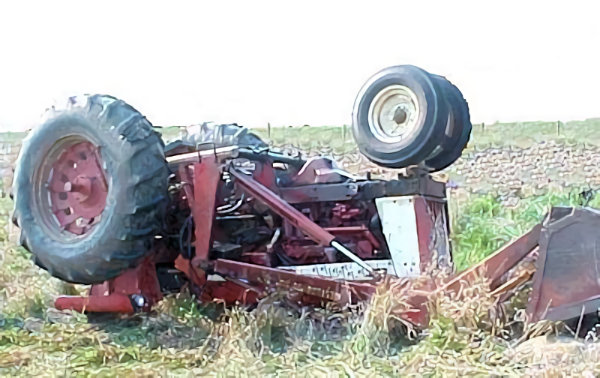Overturning Hazards
Overturning of equipment can occur when the load on the equipment is more than the capacity of the equipment.
Common causes of overturning include:
- Overloading – Placing more weight on the equipment than it is rated to carry or lift can cause instability and tipping, especially when the load is raised or shifted.
- Unbalanced loads – Even if the load is within weight limits, it can cause the equipment to tip if it is not evenly distributed. Carrying a load high and to one side increases risk.
- Operating on uneven ground – Driving on sloped or soft ground, or over debris or potholes, can cause equipment to become unstable and overturn, especially when the load is elevated.
- Sudden movements – Sharp turns, sudden stops, or rapid movements while carrying a load can shift the center of gravity and lead to tipping.
- Improper use of stabilizers – Failing to extend stabilizers or outriggers on machines like backhoes, cranes, or aerial lifts reduces support and increases the risk of overturning.
- Raising loads too high during travel – Carrying loads with the bucket or boom raised reduces stability. The higher the load, the greater the risk of tipping, especially when moving or turning.
- Driving at unsafe speeds – Excessive speed, especially with a load, can result in rollover when turning or braking suddenly.
- Improper tire inflation or worn tires – Flat or underinflated tires affect balance and increase the chance of overturn on uneven ground or while turning.
- Mechanical failure – Faulty brakes, steering components, or hydraulics can cause loss of control, which may result in an overturn incident.
- Operator error or lack of training – Inexperienced or improperly trained operators may not recognize tipping hazards or may misuse controls that lead to instability.
Example: Example: A man died when the tractor he was operating overturned and pinned him underneath. The tractor had a narrow front axle and no rollover protective structure (ROPS). A front-end loader filled with rocks was raised too high, and no counterweights were used. As he drove uphill on uneven ground, the tractor leaned and tipped. The lack of ROPS and a seat belt likely contributed to the fatality.
Driving at Excessive Speeds
Heavy equipment, such as bulldozers, loaders, and dump trucks, is built for power—not speed.
Excavator Safety
These machines are designed to move slowly and carefully on job sites to maintain control and reduce the risk of accidents. However, when heavy equipment is not carrying a load, it may feel easier to handle, and some operators might be tempted to drive faster than they should.
Driving at excessive speeds can create serious safety hazards. High speeds reduce the operator’s ability to stop quickly or steer safely, especially on uneven ground. This increases the risk of hitting obstacles, tipping over, or running into other workers on foot. On busy job sites where visibility may be limited, fast-moving equipment can lead to deadly incidents in just seconds.
Knowledge Check Choose the best answer for the question.
2-5. Why do sudden movements such as sharp turns or rapid stops increase the risk of overturning?
You forgot to answer the question!

